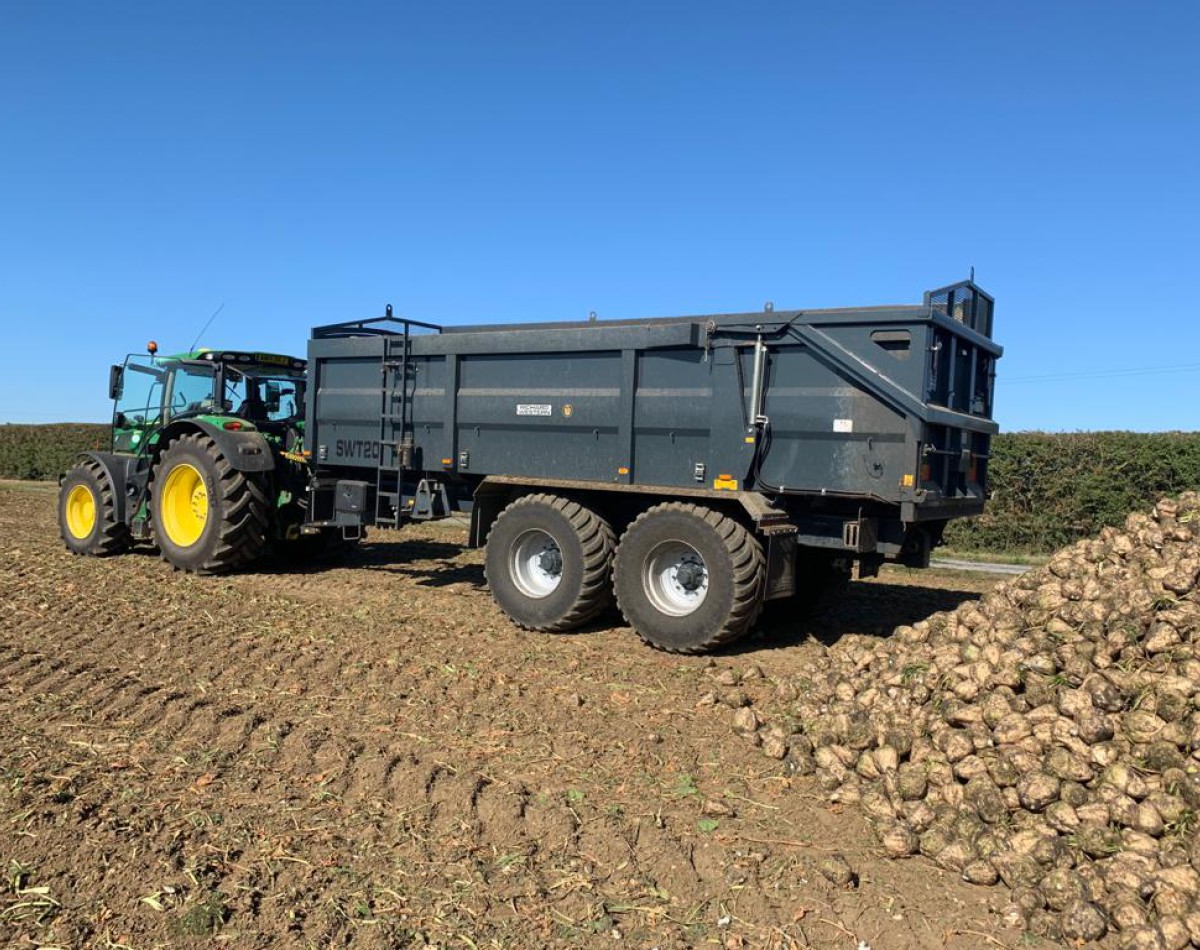Greater Capacity without Greater Compaction

When considering a new sugar beet trailer, boosting efficiency by taking a step up in capacity to match harvester output and reduce the number of loads requiring haulage doesn’t have to mean greater impact on the ground. Modern tyre equipment can make a big difference in minimising the compaction caused by laden trailers – and it’s not the only way in which a Richard Western trailer can be tailored to meet your needs.
As an example, Suffolk beet grower and contractor David Hammond, a customer of our dealer Ernest Doe Power’s Framlingham branch, recently added his largest ever trailer, a 20t-capacity Wellington model, to his existing fleet of 14t and 18t Richard Western trailers. Lifting around 760ha annually, he formerly operated a Vervaet Beet Eater 617 with 17t holding tank, but has recently upgraded to a Big Six 625 model from the same maker, with a 25t hopper.
“Moving from a conventional four-wheel harvester to a six-wheel model with eight tonnes more hopper capacity, but which spreads its weight through central wheels at the rear and turntable steering, helped us to raise output without greater impact on the soil,” David explains.
“To keep up with the machine, we wanted to add a new trailer to our fleet with greater capacity, but didn’t want to undo the progress we’d made in terms of minimising soil damage with the new harvester, particularly as all our beet is on heavy land.”
After consulting with the team at Richard Western, it was determined that it would be possible to specify a 20t-capacity Wellington trailer on Apollo Vredestein 650/55 R26.5 Flotation Trac tyres in lieu of the standard 580/65R22.5 units. When the new 20t Wellington trailer was delivered in time for the 2018/19 beet campaign, these – along with a number of other upgrades – were the tyres on which it was supplied. The Flotation Trac units feature a stable central tread and rounded shoulders to keep the tyres rolling in difficult conditions, a flexible carcass and strong belt design to provide an optimal footprint across the possible range of inflation pressures, and a robust bead construction to ensure a high degree of reliability.
“We run large flotation tyres on all our trailers, but these are the largest ones we have ever operated,” says David.
“The taller radius provides a greater ground contact patch, and while many customers comment on the size of the trailer and the tyres, they are impressed when they see the minimal footprint they leave behind. The tyres also improve the ride both in the field, where the trailer noticeably pulls more easily, and on the road
“This is also our first trailer with a steering rear axle, which has also made a big difference in reducing soil damage, particularly in the wet. The Vredesteins also look to be wearing more evenly over the front and rear axles. They’ve done two seasons and I’d expect them to do at least two more, where usually we’d probably get three years from a set.”
With the additional capacity of the new trailer, it’s possible to empty the harvester hopper more fully, leaving about three tonnes in the tank, meaning more time is available before it’s necessary to unload again.
“I was initially a bit cautious about the use of a single tipping ram for a trailer of this size, but technology has clearly moved on and I’ve got no doubts about it now after having run the trailer for two seasons. It’s very solid and stable when tipping,” says David.
“After the wet weather in the run-up to the 2019-20 beet harvest in particular, I’m glad we went for a bigger trailer to reduce the number of unloadings needed, but also for the taller tyres and steering axle that helped to minimise compaction.
“We’ve run Richard Western trailers for a long time, largely because of the specification and the way the company can pretty much build what we want. With the new trailer, that meant not just the tyre equipment, but details such as LED lights all round, four work lights – two on the tailboard and two under the front mudguards, extra mudguards on the front of the trailer to protect against tractor mudsplash, a storage box, greedy boards and a rear hitch to tow a bowser when needed. Being able to tailor-make a trailer this way means we’ve got the beet trailer we need to complete the fleet and match the harvester to get crop off the field for customers as quickly as possible with the minimum of soil disturbance.”
Jon Cottrell, agricultural tyre specialist at Apollo Vredestein, says a close relationship with customers such as Richard Western helps ensure the ideal tyre equipment can be identified for trailer buyers’ individual applications such as beet haulage.
“With the need to blend stable carrying capacity and low ground pressure, beet haulage in the field is a challenging application for a trailer tyre,” he points out.
“Beet trailers tend to be heaped high, so a maximised footprint and quality engineered casing helps provide stability, while at the same time ensuring a smooth ride, particularly important in beet applications where a high proportion of road mileage can be demanded
“Flotation Trac tyres are designed with a low rolling resistance and maximum self-cleaning properties to roll over the ground rather than biting into it and churning up the field surface.
“The tyres are manufactured with textile belting rather than steel, as this more evenly spreads the pressure points imposed by the load on the tyre, helping it ride along the soil surface. Vredestein 650/65 R26.5 174D Flotation Trac tyres have an operating capacity of 6,700kg per tyre at 65km/hr when inflated to 4.0 bar pressure, and the tyre pressure can be varied according to the speed and loads of individual operations. Using weigh cell analysis, we can help customers to set up the optimum pressures for their trailer, tractor, the application, ground conditions and land topography.”

Find your nearest dealer
From our international network
